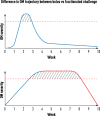A hypothesis for the pathogenesis of radiation-induced oral mucositis: when biological challenges exceed physiologic protective mechanisms. Implications for pharmacological prevention and treatment
- PMID: 33712912
- PMCID: PMC8295245
- DOI: 10.1007/s00520-021-06108-w
A hypothesis for the pathogenesis of radiation-induced oral mucositis: when biological challenges exceed physiologic protective mechanisms. Implications for pharmacological prevention and treatment
Abstract
Oral mucositis (OM) remains a significant unmet need for patients being treated with standard concomitant chemoradiation (CRT) regimens for head and neck cancers (HNC). OM's pathogenesis is complex and includes both direct and indirect damage pathways. In this paper, the field is reviewed with emphasis on the initiating and sustaining role of oxidative stress on OM's pathobiology. A hypothesis is presented which suggests that based on OM's clinical and biological trajectory, mucosal damage is largely the consequence of cumulative CRT-induced biological changes overwhelming physiologic self-protective mechanisms. Furthermore, an individual's ability to mount and maintain a protective response is dependent on interacting pathways which are primarily determined by a multiplex consisting of genomics, epigenomics, and microbiomics. Effective biologic or pharmacologic OM interventions are likely to supplement or stimulate existing physiologic damage-control mechanisms.
Keywords: Mucositis; Oxidative stress; Pathobiology; Radiation.
© 2021. The Author(s).
Conflict of interest statement
Dr. Sonis reports personal fees from Biomodels, LLC, personal fees from Primary Endpoint Solutions, LLC (PES), outside of the submitted work. As an employee of Biomodels and PES, he is involved in assisting industry, government and academics in the study, and enablement of drugs, biologicals, and devices to treat patients for a broad range of indications including cancer and oral toxicities of cancer therapy. He does not have equity or receive payment from any of the companies’ clients. This review was funded in part by a grant to PES from Galera Therapeutics which is among the companies developing a mucositis intervention based on mitigating radiation-induced oxidative stress.
Figures



Similar articles
-
Radiotherapy-induced severe oral mucositis: pharmacotherapies in recent and current clinical trials.Expert Opin Investig Drugs. 2023 Apr;32(4):301-310. doi: 10.1080/13543784.2023.2193324. Epub 2023 Mar 22. Expert Opin Investig Drugs. 2023. PMID: 36932830 Review.
-
Phenylbutyrate mouthwash mitigates oral mucositis during radiotherapy or chemoradiotherapy in patients with head-and-neck cancer.Int J Radiat Oncol Biol Phys. 2012 Mar 15;82(4):1463-70. doi: 10.1016/j.ijrobp.2011.04.029. Epub 2011 Aug 11. Int J Radiat Oncol Biol Phys. 2012. PMID: 21840136 Clinical Trial.
-
GM-1111 reduces radiation-induced oral mucositis in mice by targeting pattern recognition receptor-mediated inflammatory signaling.PLoS One. 2021 Mar 26;16(3):e0249343. doi: 10.1371/journal.pone.0249343. eCollection 2021. PLoS One. 2021. PMID: 33770116 Free PMC article.
-
Effect of photobiomodulation on the severity of oral mucositis and molecular changes in head and neck cancer patients undergoing radiotherapy: a study protocol for a cost-effectiveness randomized clinical trial.Trials. 2019 Feb 1;20(1):97. doi: 10.1186/s13063-019-3196-8. Trials. 2019. PMID: 30709370 Free PMC article.
-
Phase II investigational oral drugs for the treatment of radio/chemotherapy induced oral mucositis.Expert Opin Investig Drugs. 2018 Feb;27(2):147-154. doi: 10.1080/13543784.2018.1427732. Epub 2018 Jan 17. Expert Opin Investig Drugs. 2018. PMID: 29323575 Review.
Cited by
-
Radiation-induced rhinosinusitis: Mechanism research and clinical progress review.World J Otorhinolaryngol Head Neck Surg. 2023 Sep 4;10(4):324-332. doi: 10.1002/wjo2.134. eCollection 2024 Dec. World J Otorhinolaryngol Head Neck Surg. 2023. PMID: 39677057 Free PMC article. Review.
-
Influence of oral microbiome on longitudinal patterns of oral mucositis severity in patients with squamous cell carcinoma of the head and neck.Cancer. 2024 Jan 1;130(1):150-161. doi: 10.1002/cncr.35001. Epub 2023 Sep 8. Cancer. 2024. PMID: 37688396 Free PMC article.
-
The Effectiveness of Curcumin in Treating Oral Mucositis Related to Radiation and Chemotherapy: A Systematic Review.Antioxidants (Basel). 2024 Sep 25;13(10):1160. doi: 10.3390/antiox13101160. Antioxidants (Basel). 2024. PMID: 39456414 Free PMC article. Review.
-
The Role of the Innate Immune Response in Oral Mucositis Pathogenesis.Int J Mol Sci. 2023 Nov 14;24(22):16314. doi: 10.3390/ijms242216314. Int J Mol Sci. 2023. PMID: 38003503 Free PMC article. Review.
-
Nanoemulsion and nanoemulgel-based carriers as advanced delivery tools for the treatment of oral diseases.Drug Deliv Transl Res. 2025 Apr;15(4):1139-1155. doi: 10.1007/s13346-024-01735-2. Epub 2024 Nov 5. Drug Deliv Transl Res. 2025. PMID: 39500820 Review.
References
-
- Lalla RV et al (2019) Oral mucositis due to high-dose chemotherapy and/or head and neck radiation therapy. J Natl Cancer Inst Monogr 2019(53):Igz011 - PubMed
Publication types
MeSH terms
LinkOut - more resources
Full Text Sources
Other Literature Sources
Medical
Research Materials

